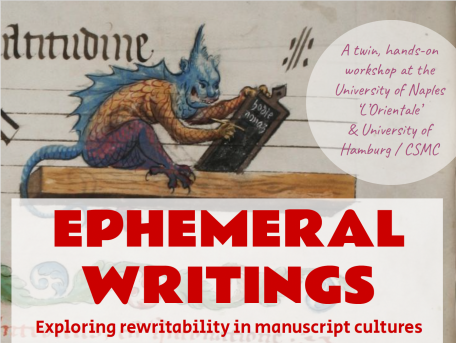EPHEMERAL WRITINGS - Exploring rewritability in manuscript cultures

Ephemeral Writings. Exploring rewritability in manuscript cultures
A twin hands-on workshop at the University of Naples ‘L’Orientale’ & University of Hamburg / CSMC
Organised by Michele Cammarosano & Claudia Colini
Part One: Clay, Wax, Papyrus, and Ink on ‘erasable coatings’
Naples, 7–9 May 2025
In collaboration with Daniele Ferraiuolo and the SCRIPTVRA project
Co-funded by the Cluster of Excellence “Understanding Written Artefacts” / Centre for the Study of Manuscript Cultures, University of Hamburg; the ERC project TabulaRasa (GA 101170566), University of Naples ‘L’Orientale’; and the Fondazione San Bonaventura, Naples
Concept
Since antiquity, the written word has been justly celebrated for its ability to outlast the perishability of human lives, travelling through centuries and millennia. However, writing is also inherently perishable: what can be written down can also be destroyed. While the term ‘destruction’ evokes images of damnatio memoriaeand book burnings, texts are most often destroyed in far more trivial circumstances, and by the will of their very creators. Among them are what we may call ‘ephemeral writings’, intentionally created to be temporary: notes, writing exercises, calculations, short-term messages, etc.
Ephemeral writings have a profound impact on the cultural and material life of literate societies, influencing writing acquisition, palaeography, text composition, transmission, and cognitive history, while linking closely to the reusability of writing supports. Manuscript cultures developed technologies for correcting and reusing surfaces, including clay and wax tablets, erasable wooden boards, and graphite or metal pens on paper. Even papyrus, parchment, ceramics, metals, and stone were reused more than commonly assumed.
While the significance of erasable media is well known, the material functioning of the related writing practices is still poorly understood, and is best investigated by combining the analysis of direct and indirect sources with informed experimentation. The twin workshop Ephemeral Writings aims to shed light on the materiality of re-writing in manuscript cultures bringing together specialists from disciplines such as codicology, palaeography, philology, source research, archaeometry, conservation, and replication to address two key questions:
1. How does ‘rewriting’ work? In particular, what material factors (environmental, physico-chemical, mechanical) influence the ability to repeatedly erase and rewrite text on specific supports (clay, ceramics, wax mixtures, papyrus, parchment, paper) using different techniques (without/with ink, metalpoint) and tools (styli, brushes, pens, quills…)? How do these factors interact with each other?
2. How does rewritability impact ephemeral writings? In particular, what role did the reusability of specific supports play in determining the preference for one technology over another in the context of ephemeral writing practices across exemplary premodern and traditional manuscript cultures?
The initiative is conceived as a twin in-person workshop held in two parts, each focusing on a different group of primary writing materials and related technologies. The first part, to be held in Naples in May 2025, is dedicated to inkless writing on clay and wax, as well as (re)writing with ink on papyrus, ceramics, wood, and ‘erasable coatings’, with a focus on the manuscript cultures of pharaonic Egypt, the ancient Near East, and classical antiquity; for wax tablets a broader chronological framework is considered in order to achieve unity in the investigation of this long-lived medium. The second part, to be held in Hamburg (date TBA), will focus on writing with ink or metalpoint on papyrus, parchment, paper, wood, and ‘erasable coatings’, with a focus on selected manuscript cultures from late antiquity to early modern times. The twin workshop combines (a) kick-off presentations (Impulsreferate), (b) hands-on replication experiments, and (c) roundtables.
Last edited date: 05/05/2025

